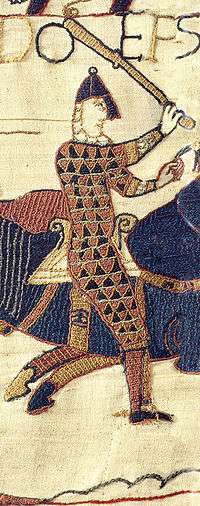Embroidery of India
Embroidery in India includes dozens of regional embroidery styles that vary by region on the varied Indian clothing styles. Designs in Indian embroidery are formed on the basis of the texture and the design of the fabric and the stitch. The dot and the alternate dot, the circle, the square, the triangle and permutations and combinations of these constitute the design.[1]
Photo gallery
 Blue mural embroidery, Udaipur, Rajasthan, India
Blue mural embroidery, Udaipur, Rajasthan, India Pink dress with embroidery, detail, Crafts Museum, New Delhi
Pink dress with embroidery, detail, Crafts Museum, New Delhi Mural embroidery, Udaipur, Rajasthan, India
Mural embroidery, Udaipur, Rajasthan, India Woman's shirt from Kutch, Gujarat, India
Woman's shirt from Kutch, Gujarat, India Embroidered hanging, Kutch (western India)
Embroidered hanging, Kutch (western India)- Embroidered textile from Nagaland, Honolulu Museum of Art
_LACMA_M.83.105.27_(4_of_21).jpg) Woman's Wrapped Garment (Sari) Uttar Pradesh
Woman's Wrapped Garment (Sari) Uttar Pradesh Green cloth with embroidery, detail, Crafts Museum, Delhi
Green cloth with embroidery, detail, Crafts Museum, Delhi Hanging from India, Honolulu Museum of Art
Hanging from India, Honolulu Museum of Art- Sari from Bengal India, 20th century, Honolulu Museum of Art
%2C_silk_and_gold-wrapped_silk_yarn_with_supplementary_weft_brocade.jpg) 'Banarasi sari' from Varanasi (Banaras), silk and gold-wrapped silk yarn with supplementary weft brocade (zari)
'Banarasi sari' from Varanasi (Banaras), silk and gold-wrapped silk yarn with supplementary weft brocade (zari) Rajasthani clothes
Rajasthani clothes- Kutch cushion embroidery
Aari
.jpg)
Aari work involves a hook, plied from the top but fed by silk thread from below with the material spread out on a frame. This movement creates loops, and repeats of these lead to a line of chain stitches.[2] The fabric is stretched on a frame and stitching is done with a long needle ending with a hook such as a crewel, tambour (a needle similar to a very fine crochet hook but with a sharp point)[3] or Luneville work. The other hand feeds the thread from the underside, and the hook brings it up, making a chainstitch, but it is much quicker than chainstitch done in the usual way: looks like machine-made and can also be embellished with sequins and beads - which are kept on the right side, and the needle goes inside their holes before plunging below, thus securing them to the fabric.
Aari embroidery is practiced in various regions such as in Kashmir[4] and Kutch (Gujarat).[5]
Banjara embroidery

Practiced by the Lambada[6] gypsy tribes of Andhra Pradesh, Banjara embroidery is a mix of applique with mirrors and beadwork. Bright red, yellow, black and white coloured cloth is laid in bands and joined with a white criss-cross stitch. The Banjaras of Madhya Pradesh who are found in the districts of Malwa and Nimar have their own style of embroidery where designs are created according to the weave of the cloth, and the textured effect is achieved by varying colours and stitches of the geometric patterns and designs. Motifs are generally highlighted by cross-stitch.
Banni or Heer Bharat (Gujarat)
The Banni or Heer Bharat embroidery originates in Gujarat, and is practiced mainly by the Lohana community. It is done with silk floss (Heer means "silk floss") and it is famous for its vibrancy and richness in color pallets & design patterns, which include shisha (mirror) work. Bagh and phulkari embroidery of the Punjab region has influenced Heer Bharat embroidery in its use of geometrical motifs and stitchery.[7]
Chamba Rumal (Himachal Pradesh)
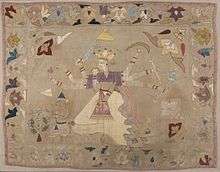
This embroidery flourished in the princely hill states of Kangra,[8] Chamba, Basholi, and other neighbouring provinces. Chamba region has highly skilled craftsmen.
Chikan or Chikankari (Uttar Pradesh)
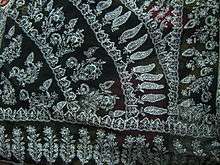
The present form of chikan (meaning elegant patterns on fabric) work is associated with the city of Lucknow, in Uttar Pradesh. Chikan embroidery on silk is Lucknow's own innovation. The other chikan styles are that of Calcutta and Dacca. However, characteristic forms of stitch were developed in Lucknow: phanda and murri.[9]
Chikan embroidery is believed to have been introduced by Nur Jahan,[10] the wife of Jahangir. Chikan embroidery involves the use of white thread on white muslin (tanzeb), fine cotton (mulmul), or voile, fine almost sheer fabrics which showcases shadow work embroidery the best. Other colours can also be used.
The artisans usually create individual motifs or butis of animals and flowers (rose, lotus, jasmine, creepers). The designs are first printed onto the fabric not with chaulk, but with a mixture of glue and indigo.
At least 40 different stitches are documented, of which about 30 are still practiced today and include flat, raised and embossed stitches, and the open trellis-like jaali work. Some of the stitches that are used in Chikankari work include: taipchi, pechni, pashni, bakhia (ulta bakhia and sidhi bakhia), gitti, jangira, murri, phanda, jaalis etc. In English: chain stitch, buttonhole stitch, French knots and running stitch, shadow work. Another is the khatao (also called khatava or katava).
Gota (Jaipur, Rajasthan)
It is a form of appliqué in gold thread, used for women’s formal attire. Small pieces of zari ribbon are applied onto the fabric with the edges sewn down to create elaborate patterns. Lengths of wider golden ribbons are stitched on the edges of the fabric to create an effect of gold zari work. Khandela in Shekhawati is famous for its manufacture. The Muslim community uses Kinari or edging, a fringed border decoration. Gota-kinari practiced mainly in Jaipur, utilising fine shapes of bird, animals, human figures which are cut and sewn on to the material.[11]
Kantha (Bengal)
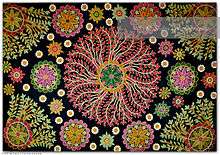
Naksha is embroidery on many layers of cloth (like quilting), with running stitch. It is also known as dorukha which mean the designs/motifs are equally visible in both sides: there is no right or wrong side so both side are usable. Traditionally, worn out clothes and saris were piled together and stitched into quilts. Rural Bengali women still do this with cotton saris, the embroidery thread being taken from the sari border. It started as a method of making quilts, but the same type of embroidery can also be found on saris, salwar suits, stoles, napkins, etc. Themes include human beings, animals, flowers, geometric designs and mythological figures.[12]
Different types include Sujani kantha, Durjani kantha, Lep kantha, Archilata kantha, Rumal kantha and Oaar kantha.
Karchobi
It is a raised zari metallic thread embroidery created by sewing flat stitches on cotton padding.[13] This technique is commonly used for bridal and formal costumes as well as for velvet coverings, tent hangings, curtains and the coverings of animal carts and temple chariots.
Kasuti or Kasuthi (Karnataka)

Kasuti (Kai=hand and Suti = cotton)comes from the state of Karnataka,[14] but also used elsewhere, as in Kanchipuram sarees. Kasuti is done with single thread and involves counting of each thread on the cloth. The patterns are stitched without knots, so that both sides of the cloth look alike. Stitches like Ganti, Murgi, Neyge and Menthe form intricate patterns like gopura, chariot, palanquin, lamps and conch shells, as well as peacocks and elephants, in fixed designs and patterns.
Kathi (Gujarat)
Kathi embroidery was introduced by 'Kathi' the cattle breeders, who were wanderers.[15] This technique combines chain stitch, appliqué work and mirror-like insertions.
Kutch or Aribharat or
The best known of the Kutch (Gujarat) embroidery techniques is Aribharat, named after the hooked needle which forms the chainstitch. It is also known as Mochibharat, as it used to be done by mochis (cobblers).[16]
Kutchi bharat/Sindhi stitch (Gujarat)
A variation of Kutch work, this geometric embroidery starts with a foundation framework of herringbone stitch or Cretan stitch, and then this framework is completely filled with interlacing. It is said that this technique originated in far away land of Armenia and found its way to Gujarat by travelling Nomads. Sindhi stitch or Maltese cross stitch is also similar but the innovation of the Kutchi women have taken it beyond the traditional designs... Kutch work[17]
Kashmiri embroidery
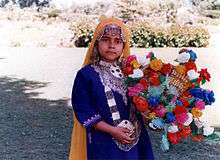

Kashmiri Kashida (Kashmir)
Kashmiri embroidery(also Kashida) is used for phirans (woollen kurtas) and namdahs (woollen rugs)as well as stoles. It draws inspiration from nature. Birds, blossoms and flowers, creepers, chinar leaves, ghobi, mangoes, lotus, and trees are the most common themes. The entire pattern is made with one or two embroidery stitches, and mainly chain stitch on a base of silk, wool and cotton: the colour is usually white, off-white or cream but nowadays one can find stoles and salwar-kameez sets in many other colours such as brown, deep blue, sky blue, maroon and rani pink. Kashida is primarily done on canvas with crystal threads, but Kashida also employs pashmina and leather threads. Apart from clothes, it's found on home furnishings like bed spreads, sofa and floor cushions, and pillow covers.
The base cloth, whether wool or cotton, is generally white or cream or a similar shade. Pastel colors are also often used. The craftsmen use shades that blend with the background. Thread colors are inspired by local flowers. Only one or two stitches are employed on one fabric.
Kashmiri embroidery is known for the skilled execution of a single stitch, which is often called the Kashmiri stitch and which may comprise the chain stitch, the satin stitch, the slanted darn stitch, the stem stitch, and the herringbone stitch. Sometimes, the doori (knot) stitches are used but not more than one or two at a time.
Kashmiri stitches
_LACMA_M.63.33.1_(1_of_4).jpg)
.jpg)
The stitches include sozni (satin), zalakdozi (chain) and vata chikan (button hole).[18] Other styles include dorukha in which the motif appears on both sides of the shawl with each side having a different color; papier-mâché; aari (hook) embroidery; shaaldaar; chinar-kaam; samovar (the antique Kashimiri tea-pot) is a very typical and popular design used in Kashmiri embroidery. The samovar pattern is then filled up with intricate flowers and leaves and twigs; Kashir-jaal which implies fine network of embroidery, particularly on the neckline and sleeves of a dress material.
Further styles include naala jaal which involves embroidery particularly on the neckline and chest/yoke: naala means neck in the Koshur dialect of Kashmiri language; jaama is a very dense embroidery covering the whole base fabric with a thick spread of vine/creepers and flowers, badaam and heart shapes, a variation of this form is neem-jaama, where neem means demi or half, because the embroidery is less dense, allowing a view of the fabric underneath; and jaal consisting of bel-buti: a fine and sparse net of vine/creepers and flowers. Variation of this form is neem-jaal, where again the work is less dense.
Mukesh
Small rectangular pieces of metal are squeezed shut around some threads of the fabric. Mukesh work (known also as badla or fardi), includes women making shiny stitches amid chikan embroidery using a needle and long, thin strips of metal.[19]
Phool patti Ka Kaam (Uttar Pradesh)
Flower embroidery of Uttar Pradesh,[20] especially in Aligarh.
Punjabi embroidery
Phulkari (Punjab and Haryana)

_LACMA_M.64.24.1.jpg)
Phulkari (Phul=flower, Kari=work) is the most famous rural embroidery tradition of Punjab, mentioned in the Punjabi folklore of Heer Ranjha by Waris Shah. Its present form and popularity goes back to 15th century, during Maharaja Ranjit Singh’s reign[21] Phulkari also means headscarf, and it comes from the 19th century tradition of carrying an odhani or a head-scarf with flower patterns. Its distinctive property is that the base is a dull hand-spun or khadi cloth, with bright coloured threads that cover it completely, leaving no gaps. It uses a darn stitch done from the wrong side of the fabric using darning needles, one thread at a time, leaving a long stitch below to form the basic pattern.[22] Famous for Phulkari are the cities of [23] Amritsar,[23] Jalandhar,[23] Ambala,[23] Ludhiana,[23] Nabha,[23] Jind,[23] Faridkot,[23] and Kapurthala.[23] Other cities include Gurgaon (Haryana), Karnal, Hissar, Rohtak and Delhi. Bagh is an offshoot of phulkari and almost always follows a geometric pattern, with green as its basic colour.
Other styles
The emroidery styles of the Punjab region include kalabatun embroidery[24] using thin wires. Kalabatan surkh involves using gold wires on orange coloured and red silk. Kalabatan safed involves using silver wires on white material. There are two kinds of gold embroidery, one of a solid and rich kind called kar-chob and the other called tila-kar or kar-chikan utilising gold thread. The former is used for carpets and saddle cloths whereas the latter is used for dresses. The Punjab region also uses mukesh embroidery: mukesh bati-hui, twisted tinsel, mukesh gokru, flattened gold wire for embroidery of a heavy kind, and waved mukesh, made by crimping mukesh batihui with iron tongs.[25] Ludhiana and Amritsar are known for embroidery using white, silver and gold threads on clothes such as chogas and waistcoats (phatuhi).[8] Patchwork is also a tradition of the region.
Pichwai (Rajasthan)

Colourful embroidered cloth-hangings made in Nathdwara, Rajasthan. The central themes focus on Lord Krishna.[26]
Pipli (Odisha)
Appliqué[27] or Pipli work originates from the Pipli[28] village in Odisha and some parts of Gujarat. It is based on patchwork: brightly coloured and patterned fabric pieces are sewn together on a plain background. Designs include human forms, animals and vehicles. Originally this technique was used for parasols, canopies and pillows for the Rath Yatra Nowadays different home décor items can be found, such as lamp shades, garden umbrellas and bed covers.
Rabari (Rajasthan and Gujarat)
This embroidery style is made by the Rabari[29] or Rewari community of Rajasthan and Gujarat. This very colourful embroidery style, using stark contrast was traditionally used only for garments, but now it can be found on bags, accessories, home furnishings, etc. Mirrors of all shapes and sizes are incorporated in the embroidery, as a result of the belief that mirrors protect from evil spirits. Designs include not only flowers and fruit and animals such as parrots and elephants, but also temples, women carrying pots, and the ubiquitus mango shape.
Shamilami (Manipur)
A combination of weaving and embroidery and was once a high status symbol.[30]
Shisha or Mirrorwork (Gujarat, Rajasthan)
%2C_Saurashtra%2C_Gujarat%2C_India%2C_20th_Century%2C_cotton%2C_metal_and_mirror_pieces._plain_weave_with_embroidery_and_mirror_work%2C_Honolulu_Academy_of_Arts.jpg)
This ornamentation method originated in Persia during 13th century and involves little pieces of mirror in various sizes which are encased in the decoration of the fabric first by interlacing threads and then with buttonhole stitch.[31]
Originally, pieces of mica were used as the mirrors, but later, people started using thin blown-glass pieces, hence the name, which in Hindi means "little glass".[32] Until recently they were all irregular, made by hand, and used mercury, nowadays one can also find them machine made and regularly shaped. It's usually found in combination with other types of stitches like cross stitch, buttonhole stitch and satin stitch, nowadays not only by hand but also by machine. Mirrorwork is very popular for cushion covers and bedcovers, purses and decorative hangings as well as in decorative borders in women's salwar-kameez and sari.
There are various types of chikan work: Taipchi, Bakhia, Phunda, Murri, Jaali, Hathkati, Pechni, Ghas Patti, and Chaana Patti.
Toda embroidery
The Toda embroidery has its origins in Tamil Nadu. The Nilgiri Hills, inhabited by the Todu community have their own style called pugur, means flower. This embroidery, like Kantha, is practiced by women.
The embroidery adorns the shawls. The shawl, called poothkuli, has red and black bands between which the embroidery is done. As Todas worship the buffaloes, buffalo becomes an important motif in the Toda embroidery among mettvi kaanpugur, Izhadvinpuguti and others. Stylized sun, moon, stars and the eye of the peacock feathers are used in Toda embroidery.[33]
Zardozi or Zari or kalabattu
_Embroidery_Cushion_Covers.jpg)
%2C_late_19th_or_early_20th_century%2C_silk_with_metallic_thread%2CHAA.jpg)
The most opulent form of Indian embroidery is the Zari and the Zardozi, known since the late 16th century, brought in India by the mighty Moghuls. The word Zardozi comes from the two Persian words Zar=gold and Dozi=embroidery. This form uses metallic thread.
Once real gold and silver thread was used, on silk, brocade and velvet fabric. Metal ingots were melted and pressed through perforated steel sheets to convert into wires, which then were hammered to the required thinness. Plain wire is called "badla:, and when wound round a thread, it is called "kasav". Smaller spangles are called "sitara" and tiny dots made of badla are called "mukais" or "mukesh".
Zardozi is either a synonym or a more elaborate version of zari where the gold or silver embroidery is embellished with pearls and precious stones, gota and kinari, making this art only affordable by rich people.
Nowadays Zardosi thread has a plastic core and a golden-coloured outside. The thread consists of coiled metal wires placed on the right side of the fabric and couched with a thinner thread.
See also
- Chikan (embroidery) - embroidery of Lucknow
- Phulkari - embroidery of Punjab Region
References
- ↑ http://www.hrpc.com.vn/index.php?option=com_content&view=article&id=46:embroidery-arts-of-india&catid=6:crafts-in-the-world&Itemid=13
- ↑ Sajnani, Manohar (2001) Encyclopaedia of Tourism Resources in India, Volume 2
- ↑ Wood, Dorothy (2008) The Beader's Bible
- ↑ Mehta, Vinod (2006) Delhi and NCR city guide
- ↑ HALI., Issues 117-119 2001
- ↑ Ms. Jaslean Dhamija (2013) Asian Embroidery
- ↑ Naik, Shailaja D. (1996) Traditional Embroideries of India
- 1 2 Mohinder Singh Randhawa. (1960) Punjab: Itihas, Kala, Sahit, te Sabiachar aad.Bhasha Vibhag, Punjab, Patiala.
- ↑ Trivedi, Madhu (2010) The Making of the Awadh Culture
- ↑ Bhushan, Jamila Brij (1990) Indian Embroidery
- ↑ Shailaja D. Naik (1996) Traditional Embroideries of India
- ↑ Indian Heritage
- ↑ Knopf, 1996 Rajasthan
- ↑ Karine Schomer, W. H. McLeod (1987) The Sants: Studies in a Devotional Tradition of India
- ↑ Shailaja D. Naik (1996) Traditional Embroideries of India
- ↑ Indian Embroidery
- ↑ Indian Heritage
- ↑ Shailaja D. Naik (1996) Traditional Embroideries of India
- ↑ Clare M. Wilkinson-Weber (1999) Embroidering Lives: Women's Work and Skill in the Lucknow Embroidery Industry
- ↑ Textile Trends, Volume 44 2001
- ↑ http://daily.indianroots.com/phulkari-sikh-awareness-appreciation-month/
- ↑ http://daily.indianroots.com/indian-embroidery-styles/
- 1 2 3 4 5 6 7 8 9 Sukaadas (1992) Fabric Art: Heritage of India
- ↑ Ramananda Chatterjee (1939) The Modern Review, Volume 66, Issues 1-6
- ↑ Baden-Powell, Baden Henry (1872)Hand-book of the Manufactures & Arts of the Punjab: With a Combined Glossary & Index of Vernacular Trades & Technical Terms ... Forming Vol. Ii to the "Hand-book of the Economic Products of the Punjab" Prepared Under the Orders of Government
- ↑ Naik, Shailaja D. (1996) Traditional Embroideries of India
- ↑ an and Foreign Review, Volume 23 (1985)
- ↑ Shailaja D. Naik (1996) Traditional Embroideries of India
- ↑ Ms. Jaslean Dhamija (2013) Asian Embroidery
- ↑ D. N. Saraf (1991) D.N. Saraf in the Journey of Craft Development, 1941-1991: Reminiscences
- ↑ http://www.joyfulabode.com/wp-content/uploads/HLIC/06b8a8306d1f3e827c1315df03f240e4.jpg
- ↑ http://www.joyfulabode.com/tutorial-indian-shisha-mirror-embroidery/
- ↑ Ms. Dhamija, Jaslean (2013) Asian Embroidery
External links
- Kasuti blog
- A modern take on Kasuti
- Indian embroidery types
- Description and drawings of common embroidery stitches
- Mirror embroidery tutorial
- Indian embroidery
| Wikimedia Commons has media related to Embroidery of India. |
